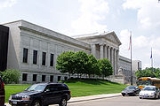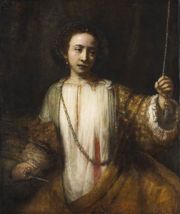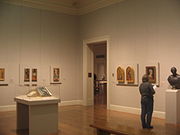
Minneapolis Institute of Arts
Encyclopedia
The Minneapolis Institute of Arts (MIA) is a fine art
museum
located in the Whittier
neighborhood of Minneapolis, Minnesota
, on a campus that covers nearly 8 acre
s (32,000 m²), formerly Morrison Park. As a major, government-funded public museum, the Institute does not charge an entrance fee, except for special exhibitions, and allows photography
of its permanent collection for personal or scholarly use only. The museum receives support from the Park Board Museum Fund, levied by the Hennepin County commissioners. Additional funding is provided by corporate sponsors and museum members.
 The Minneapolis Society of Fine Arts began in 1883 to bring the arts into the life of the community. This group, made up of business and professional leaders of the time, organized art exhibits throughout the decade. In 1889, the Society, now known as the Minneapolis Institute of Arts, moved into its first permanent space inside the newly built Minneapolis Public Library
The Minneapolis Society of Fine Arts began in 1883 to bring the arts into the life of the community. This group, made up of business and professional leaders of the time, organized art exhibits throughout the decade. In 1889, the Society, now known as the Minneapolis Institute of Arts, moved into its first permanent space inside the newly built Minneapolis Public Library
.
A new museum building, designed by the firm of McKim, Mead and White, opened its doors in 1915. Built on land donated by the Morrison family formerly occupied by their Villa Rosa mansion, the museum came to be recognized as one of the finest examples of the Beaux-Arts architectural style
in Minnesota. Art historian Bevis Hillier
organized an exhibition called Art Deco
at the MIA that took place from July to September 1971, which caused a great resurgence of interest in this style of art. The building was originally meant to be the first of several sections but only this front piece was ultimately built; several additions have subsequently been built according to other plans, including a 1974 addition by Kenzo Tange
. An expansion designed by Michael Graves
was completed in June 2006.
The building is located within the Washburn-Fair Oaks Mansion District
, a neighborhood of mansions built by wealthy Minneapolis business leaders between 1880 and 1920. The district is listed in the National Register of Historic Places
.
 The MIA features an encyclopedic collection of approximately 80,000 objects spanning 5,000 years of world history. Its collection includes paintings, photographs, prints
The MIA features an encyclopedic collection of approximately 80,000 objects spanning 5,000 years of world history. Its collection includes paintings, photographs, prints
& drawings, textiles, architecture
, and decorative arts. There are collections of African art
and art from Oceania and the Americas, and an especially strong collection of Asian art
, called "one of the finest and most comprehensive Asian art collections in the country". The Asian collection includes Chinese architecture
, jades
, bronzes
, and ceramic
s.
has created “Curatorial Councils” aligned with the seven curatorial areas of the museum. The councils schedule lectures, symposia
, and travel for members.
The MIA features a regular series of exhibitions
that bring in traveling collections from other museums for display. Local business partners fund many of these exhibitions and some feature the artists themselves leading public tours through the exhibition.
The MIA also houses the Minnesota Artists Exhibition Program (MAEP). The MAEP is an artist-controlled program devoted to the exhibition of works by artists who live in Minnesota.
Fine art
Fine art or the fine arts encompass art forms developed primarily for aesthetics and/or concept rather than practical application. Art is often a synonym for fine art, as employed in the term "art gallery"....
museum
Museum
A museum is an institution that cares for a collection of artifacts and other objects of scientific, artistic, cultural, or historical importance and makes them available for public viewing through exhibits that may be permanent or temporary. Most large museums are located in major cities...
located in the Whittier
Whittier, Minneapolis
Whittier is a neighborhood in the U.S. city of Minneapolis, Minnesota, bounded by Franklin Avenue on the north, Interstate 35W on the east, Lake Street on the south, and Lyndale Avenue on the west. It is known for many diverse restaurants, coffee shops and Asian markets, especially along Nicollet...
neighborhood of Minneapolis, Minnesota
Minnesota
Minnesota is a U.S. state located in the Midwestern United States. The twelfth largest state of the U.S., it is the twenty-first most populous, with 5.3 million residents. Minnesota was carved out of the eastern half of the Minnesota Territory and admitted to the Union as the thirty-second state...
, on a campus that covers nearly 8 acre
Acre
The acre is a unit of area in a number of different systems, including the imperial and U.S. customary systems. The most commonly used acres today are the international acre and, in the United States, the survey acre. The most common use of the acre is to measure tracts of land.The acre is related...
s (32,000 m²), formerly Morrison Park. As a major, government-funded public museum, the Institute does not charge an entrance fee, except for special exhibitions, and allows photography
Photography
Photography is the art, science and practice of creating durable images by recording light or other electromagnetic radiation, either electronically by means of an image sensor or chemically by means of a light-sensitive material such as photographic film...
of its permanent collection for personal or scholarly use only. The museum receives support from the Park Board Museum Fund, levied by the Hennepin County commissioners. Additional funding is provided by corporate sponsors and museum members.
History

Minneapolis Public Library
The Minneapolis Public Library and Information Center was a library system serving the residents of Minneapolis, Minnesota in the United States. It was founded as the publicly traded Minneapolis Athenæum in 1860 and became a free public library in 1885 founded by T. B. Walker...
.
A new museum building, designed by the firm of McKim, Mead and White, opened its doors in 1915. Built on land donated by the Morrison family formerly occupied by their Villa Rosa mansion, the museum came to be recognized as one of the finest examples of the Beaux-Arts architectural style
Architectural style
Architectural styles classify architecture in terms of the use of form, techniques, materials, time period, region and other stylistic influences. It overlaps with, and emerges from the study of the evolution and history of architecture...
in Minnesota. Art historian Bevis Hillier
Bevis Hillier
Bevis Hillier is an English art historian, author and journalist. He has written on Art Deco, and also a biography of Sir John Betjeman.-Life and work:...
organized an exhibition called Art Deco
Art Deco
Art deco , or deco, is an eclectic artistic and design style that began in Paris in the 1920s and flourished internationally throughout the 1930s, into the World War II era. The style influenced all areas of design, including architecture and interior design, industrial design, fashion and...
at the MIA that took place from July to September 1971, which caused a great resurgence of interest in this style of art. The building was originally meant to be the first of several sections but only this front piece was ultimately built; several additions have subsequently been built according to other plans, including a 1974 addition by Kenzo Tange
Kenzo Tange
was a Japanese architect, and winner of the 1987 Pritzker Prize for architecture. He was one of the most significant architects of the 20th century, combining traditional Japanese styles with modernism, and designed major buildings on five continents. Tange was also an influential protagonist of...
. An expansion designed by Michael Graves
Michael Graves
Michael Graves is an American architect. Identified as one of The New York Five, Graves has become a household name with his designs for domestic products sold at Target stores in the United States....
was completed in June 2006.
The building is located within the Washburn-Fair Oaks Mansion District
Washburn-Fair Oaks Mansion District
The Washburn-Fair Oaks Mansion District is a historic district in the Whittier neighborhood of Minneapolis, Minnesota centered around Washburn-Fair Oaks Park. The city of Minneapolis designated a district bordered by Franklin Avenue, Fourth Avenue South, 26th Street East, and First Avenue South...
, a neighborhood of mansions built by wealthy Minneapolis business leaders between 1880 and 1920. The district is listed in the National Register of Historic Places
National Register of Historic Places
The National Register of Historic Places is the United States government's official list of districts, sites, buildings, structures, and objects deemed worthy of preservation...
.
Collections

Printmaking
Printmaking is the process of making artworks by printing, normally on paper. Printmaking normally covers only the process of creating prints with an element of originality, rather than just being a photographic reproduction of a painting. Except in the case of monotyping, the process is capable...
& drawings, textiles, architecture
Architecture
Architecture is both the process and product of planning, designing and construction. Architectural works, in the material form of buildings, are often perceived as cultural and political symbols and as works of art...
, and decorative arts. There are collections of African art
African art
African art constitutes one of the most diverse legacies on earth. Though many casual observers tend to generalize "traditional" African art, the continent is full of people, societies, and civilizations, each with a unique visual special culture. The definition also includes the art of the African...
and art from Oceania and the Americas, and an especially strong collection of Asian art
Asian art
Asian art can refer to art amongst many cultures in Asia.-Various types of Asian art:*Afghan art*Azerbaijanian art*Balinese art*Bhutanese art*Buddhist art*Burmese contemporary art*Chinese art*Eastern art*Indian art*Iranian art*Islamic art...
, called "one of the finest and most comprehensive Asian art collections in the country". The Asian collection includes Chinese architecture
Chinese architecture
Chinese architecture refers to a style of architecture that has taken shape in East Asia over many centuries. The structural principles of Chinese architecture have remained largely unchanged, the main changes being only the decorative details...
, jades
Chinese jade
Chinese jade is any of the carved-jade objects produced in China from the Neolithic Period onward. The Chinese regarded carved-jade objects as intrinsically valuable...
, bronzes
Bronze sculpture
Bronze is the most popular metal for cast metal sculptures; a cast bronze sculpture is often called simply a "bronze".Common bronze alloys have the unusual and desirable property of expanding slightly just before they set, thus filling the finest details of a mold. Then, as the bronze cools, it...
, and ceramic
Ceramic
A ceramic is an inorganic, nonmetallic solid prepared by the action of heat and subsequent cooling. Ceramic materials may have a crystalline or partly crystalline structure, or may be amorphous...
s.
Services
In order to encourage private collecting and assist in the acquisition of important works of art, the museumMuseum
A museum is an institution that cares for a collection of artifacts and other objects of scientific, artistic, cultural, or historical importance and makes them available for public viewing through exhibits that may be permanent or temporary. Most large museums are located in major cities...
has created “Curatorial Councils” aligned with the seven curatorial areas of the museum. The councils schedule lectures, symposia
Symposium
In ancient Greece, the symposium was a drinking party. Literary works that describe or take place at a symposium include two Socratic dialogues, Plato's Symposium and Xenophon's Symposium, as well as a number of Greek poems such as the elegies of Theognis of Megara...
, and travel for members.
The MIA features a regular series of exhibitions
Art exhibition
Art exhibitions are traditionally the space in which art objects meet an audience. The exhibit is universally understood to be for some temporary period unless, as is rarely true, it is stated to be a "permanent exhibition". In American English, they may be called "exhibit", "exposition" or...
that bring in traveling collections from other museums for display. Local business partners fund many of these exhibitions and some feature the artists themselves leading public tours through the exhibition.
The MIA also houses the Minnesota Artists Exhibition Program (MAEP). The MAEP is an artist-controlled program devoted to the exhibition of works by artists who live in Minnesota.

